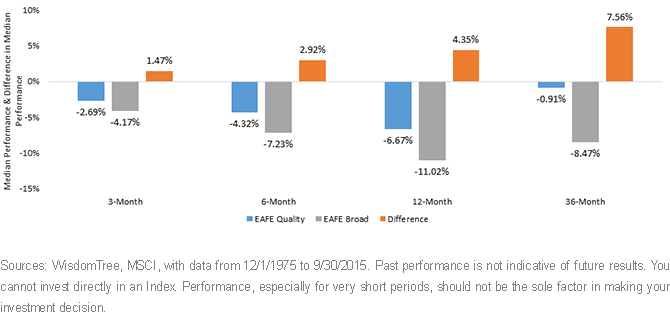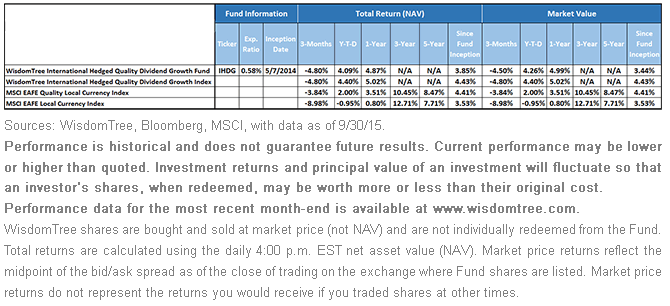Benefits of Quality Apparent During Volatile Q3


 At a high level, based on what we see in the chart, there was median outperformance of EAFE Quality over EAFE Broad over each of the rolling period frequencies—3, 6, 12 and 36 months—when the return of EAFE Broad was negative.
• Big Declines of 5% or More: Digging a little deeper into the three-month analysis, since we began our focus talking about the third quarter of 2015, there were actually 70 three-month periods from December 1, 1975, to September 30, 2015, in which the returns for the MSCI EAFE Index declined more than 5%.
• Median outperformance of EAFE Quality in those periods was approximately 3%, while in all other periods the median differential was essentially zero.
• Looking again a bit further at the rolling three-month analysis, there were 126 three-month periods in which returns for EAFE Broad declined more than 1%. Median outperformance of quality in those periods was close to 2 percentage points, while in all other rolling three-month periods, the median differential was negative 18 basis points (bps) , meaning that EAFE broad slightly outperformed EAFE Quality during positive environments.
• This research suggests quality as a factor had some of its best returns for the EAFE universe during down markets, declining less than EAFE Broad.
The Third Quarter of 2015
Now that we know our expectations of how quality might perform in difficult markets, it’s time to look at the third quarter of 2015. Importantly, the WisdomTree International Hedged Quality Dividend Growth Fund (IHDG) tracks the performance of the WisdomTree International Hedged Quality Dividend Growth Index before fees and expenses. This Index represents WisdomTree’s approach to quality in the developed international equities.
Zooming In on the Third Quarter and Year-to-Date Periods of 2015 (as of September 30, 2015)
At a high level, based on what we see in the chart, there was median outperformance of EAFE Quality over EAFE Broad over each of the rolling period frequencies—3, 6, 12 and 36 months—when the return of EAFE Broad was negative.
• Big Declines of 5% or More: Digging a little deeper into the three-month analysis, since we began our focus talking about the third quarter of 2015, there were actually 70 three-month periods from December 1, 1975, to September 30, 2015, in which the returns for the MSCI EAFE Index declined more than 5%.
• Median outperformance of EAFE Quality in those periods was approximately 3%, while in all other periods the median differential was essentially zero.
• Looking again a bit further at the rolling three-month analysis, there were 126 three-month periods in which returns for EAFE Broad declined more than 1%. Median outperformance of quality in those periods was close to 2 percentage points, while in all other rolling three-month periods, the median differential was negative 18 basis points (bps) , meaning that EAFE broad slightly outperformed EAFE Quality during positive environments.
• This research suggests quality as a factor had some of its best returns for the EAFE universe during down markets, declining less than EAFE Broad.
The Third Quarter of 2015
Now that we know our expectations of how quality might perform in difficult markets, it’s time to look at the third quarter of 2015. Importantly, the WisdomTree International Hedged Quality Dividend Growth Fund (IHDG) tracks the performance of the WisdomTree International Hedged Quality Dividend Growth Index before fees and expenses. This Index represents WisdomTree’s approach to quality in the developed international equities.
Zooming In on the Third Quarter and Year-to-Date Periods of 2015 (as of September 30, 2015)
 Average Annual Returns as of September 30, 2015
Average Annual Returns as of September 30, 2015
 • In Q3, the EAFE Broad was down nearly 9%, but IHDG was down merely 4.8%. This is approximately 4.2% outperformance. EAFE Quality also outperformed EAFE Broad by more than 5 percentage points. Median outperformance of EAFE Quality over EAFE Broad when EAFE Broad was negative was closer to 1.5%, so this represents a significant period, in our view.
• Broadening to the year-to-date 2015 period, we see that EAFE Broad delivered a negative return of nearly 1.0%. EAFE Quality was up 2.0%, and IHDG was up nearly 4.1% over this same time frame.
While we recognize that this was just one single three-month period (as well as one single year-to-date nine-month period), we still believe it to be worth noting. If people think markets could continue to exhibit volatility similar to what was seen in the third quarter of 2015, we think that looking toward quality should be of particular interest.
1Source: Bloomberg, as of 9/30/15.
• In Q3, the EAFE Broad was down nearly 9%, but IHDG was down merely 4.8%. This is approximately 4.2% outperformance. EAFE Quality also outperformed EAFE Broad by more than 5 percentage points. Median outperformance of EAFE Quality over EAFE Broad when EAFE Broad was negative was closer to 1.5%, so this represents a significant period, in our view.
• Broadening to the year-to-date 2015 period, we see that EAFE Broad delivered a negative return of nearly 1.0%. EAFE Quality was up 2.0%, and IHDG was up nearly 4.1% over this same time frame.
While we recognize that this was just one single three-month period (as well as one single year-to-date nine-month period), we still believe it to be worth noting. If people think markets could continue to exhibit volatility similar to what was seen in the third quarter of 2015, we think that looking toward quality should be of particular interest.
1Source: Bloomberg, as of 9/30/15.
Important Risks Related to this Article
There are risks associated with investing, including possible loss of principal. Foreign investing involves special risks, such as risk of loss from currency fluctuation or political or economic uncertainty. To the extent the Fund invests a significant portion of its assets in the securities of companies of a single country or region, it is likely to be impacted by the events or conditions affecting that country or region. Dividends are not guaranteed, and a company currently paying dividends may cease paying dividends at any time. Investments in currency involve additional special risks, such as credit risk and interest rate fluctuations. Derivative investments can be volatile, and these investments may be less liquid than other securities, and more sensitive to the effects of varied economic conditions. As this Fund can have a high concentration in some issuers, the Fund can be adversely impacted by changes affecting those issuers. The Fund invests in the securities included in, or representative of, its Index regardless of their investment merit, and the Fund does not attempt to outperform its Index or take defensive positions in declining markets. Due to the investment strategy of this Fund, it may make higher capital gain distributions than other ETFs. Please read the Fund’s prospectus for specific details regarding the Fund’s risk profile.

Christopher Gannatti began at WisdomTree as a Research Analyst in December 2010, working directly with Jeremy Schwartz, CFA®, Director of Research. In January of 2014, he was promoted to Associate Director of Research where he was responsible to lead different groups of analysts and strategists within the broader Research team at WisdomTree. In February of 2018, Christopher was promoted to Head of Research, Europe, where he was based out of WisdomTree’s London office and was responsible for the full WisdomTree research effort within the European market, as well as supporting the UCITs platform globally. In November 2021, Christopher was promoted to Global Head of Research, now responsible for numerous communications on investment strategy globally, particularly in the thematic equity space. Christopher came to WisdomTree from Lord Abbett, where he worked for four and a half years as a Regional Consultant. He received his MBA in Quantitative Finance, Accounting, and Economics from NYU’s Stern School of Business in 2010, and he received his bachelor’s degree from Colgate University in Economics in 2006. Christopher is a holder of the Chartered Financial Analyst Designation.

